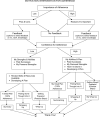The initial feasibility of a computer-based motivational intervention for adherence for youth newly recommended to start antiretroviral treatment
- PMID: 23869650
- PMCID: PMC3872202
- DOI: 10.1080/09540121.2013.813624
The initial feasibility of a computer-based motivational intervention for adherence for youth newly recommended to start antiretroviral treatment
Abstract
Young people represent the largest number of new HIV infections, thus youth living with HIV (YLH) are likely to be the largest group to initiate antiretroviral treatment (ART). Adherence patterns for behaviorally infected YLH are not adequate to effectively manage the disease; therefore, novel interventions are needed to improve medication adherence. The purpose of the current study, which will precede a randomized controlled trial, was to assess the initial feasibility of an individually tailored computer-based two-session interactive motivational interviewing (MI) intervention for YLH newly recommended to start ART. Intervention development occurred in collaboration with three youth advisory groups. Ten youth (ages 18-24) were recruited to participate in this study. Participants completed the intervention online. Intervention components focused on medication adherence (rating perceived importance and confidence, and goal setting). Retention was 100% for both intervention sessions. All participants (n=10) felt medication adherence was important, but 80% felt confident they could manage their adherence to HIV medications. Ninety percent of participants set the goal of taking their HIV medications exactly as prescribed and reported success achieving this goal at follow-up. Additionally, participants were satisfied with the quality of the sessions and the amount of assistance they received for managing their adherence to HIV medications (90% participants for Session 1; 89% for Session 2). Per exit interview responses, participants felt that the intervention made them think more about their health and was a motivator for them to take better care of their health. In conclusion, the intervention was feasible for YLH enrolled in the study.
Similar articles
-
Predictors of medication adherence in high risk youth of color living with HIV.J Pediatr Psychol. 2010 Jul;35(6):593-601. doi: 10.1093/jpepsy/jsp080. Epub 2009 Sep 15. J Pediatr Psychol. 2010. PMID: 19755495 Free PMC article. Clinical Trial.
-
Protocol of a two arm randomised, multi-centre, 12-month controlled trial: evaluating the impact of a Cognitive Behavioural Therapy (CBT)-based intervention Supporting UPtake and Adherence to antiretrovirals (SUPA) in adults with HIV.BMC Public Health. 2019 Jul 8;19(1):905. doi: 10.1186/s12889-019-6893-z. BMC Public Health. 2019. PMID: 31286908 Free PMC article.
-
Feasibility of interactive text message response (ITR) as a novel, real-time measure of adherence to antiretroviral therapy for HIV+ youth.AIDS Behav. 2013 Jul;17(6):2237-43. doi: 10.1007/s10461-013-0464-6. AIDS Behav. 2013. PMID: 23546844 Clinical Trial.
-
Interventions to Improve Antiretroviral Therapy Adherence Among Adolescents and Youth in Low- and Middle-Income Countries: A Systematic Review 2015-2019.AIDS Behav. 2020 Oct;24(10):2797-2810. doi: 10.1007/s10461-020-02822-4. AIDS Behav. 2020. PMID: 32152815 Free PMC article.
-
Adherence to HIV Care and Associated Health Functioning among Youth Living with HIV in Sub-Saharan Africa.AIDS Rev. 2020 Jul 8;22(2):93-102. doi: 10.24875/AIDSRev.20000101. AIDS Rev. 2020. PMID: 32180589 Free PMC article. Review.
Cited by
-
Can chatbots help to motivate smoking cessation? A study on the effectiveness of motivational interviewing on engagement and therapeutic alliance.BMC Public Health. 2022 Apr 12;22(1):726. doi: 10.1186/s12889-022-13115-x. BMC Public Health. 2022. PMID: 35413887 Free PMC article. Clinical Trial.
-
Computerized Intervention to Increase Motivation for Diabetes Self-Management in Adolescents with Type 1 Diabetes.Health Psychol Behav Med. 2015;3(1):236-250. doi: 10.1080/21642850.2015.1079716. Epub 2015 Sep 3. Health Psychol Behav Med. 2015. PMID: 26973800 Free PMC article. No abstract available.
-
Improving Diabetes Management in Emerging Adulthood: An Intervention Development Study Using the Multiphase Optimization Strategy.JMIR Res Protoc. 2020 Oct 20;9(10):e20191. doi: 10.2196/20191. JMIR Res Protoc. 2020. PMID: 33079068 Free PMC article.
-
Adolescent Trials Network for HIV-AIDS Scale It Up Program: Protocol for a Rational and Overview.JMIR Res Protoc. 2019 Feb 1;8(2):e11204. doi: 10.2196/11204. JMIR Res Protoc. 2019. PMID: 30707102 Free PMC article.
-
eHealth to Enhance Treatment Adherence Among Youth Living with HIV.Curr HIV/AIDS Rep. 2018 Aug;15(4):336-349. doi: 10.1007/s11904-018-0407-y. Curr HIV/AIDS Rep. 2018. PMID: 29959649 Free PMC article. Review.
References
-
- Adamian MS, Golin CE, Shain LS, DeVellis B. Brief motivational interviewing to improve adherence to antiretroviral therapy: Development and qualitative pilot assessment of an intervention. AIDS Patient Care and STDs. 2004;18(4):229–238. doi:10.1089/108729104323038900. - PubMed
-
- Centers for Disease Control and Prevention (CDC) HIV surveillance report: Diagnoses of HIV infection and AIDS in the United States and dependent areas. 2011;23 Retrieved from http://www.cdc.gov/hiv/library/reports/surveillance/index.html.
-
- Centers for Disease Control and Prevention (CDC) HIV among youth in the us: Protecting a generation. 2012 Retrieved from http://m.cdc.gov/en/VitalSigns/hiv-among-youth-in-the-us.
-
- Fisher JD, Amico KR, Fisher WA, Cornman DH, Shuper PA, Trayling C, Friedland G. Computer-based intervention in HIV clinical care setting improves antiretroviral adherence: The Life-Windows project. AIDS and Behavior. 2011;15(8):1635–1646. doi:10.1007/s10461-011-9926-x. - PubMed
-
- Hesse-Biber S, Leavy P. Content analysis and unobtrusive methods. In: Hesse-Biber S, Leavy P, editors. The practice of qualitative research. 2nd ed. Sage Publications; Los Angeles, CA: 2010. pp. 227–254.
Publication types
MeSH terms
Substances
Grants and funding
LinkOut - more resources
Full Text Sources
Other Literature Sources
Medical
Molecular Biology Databases


